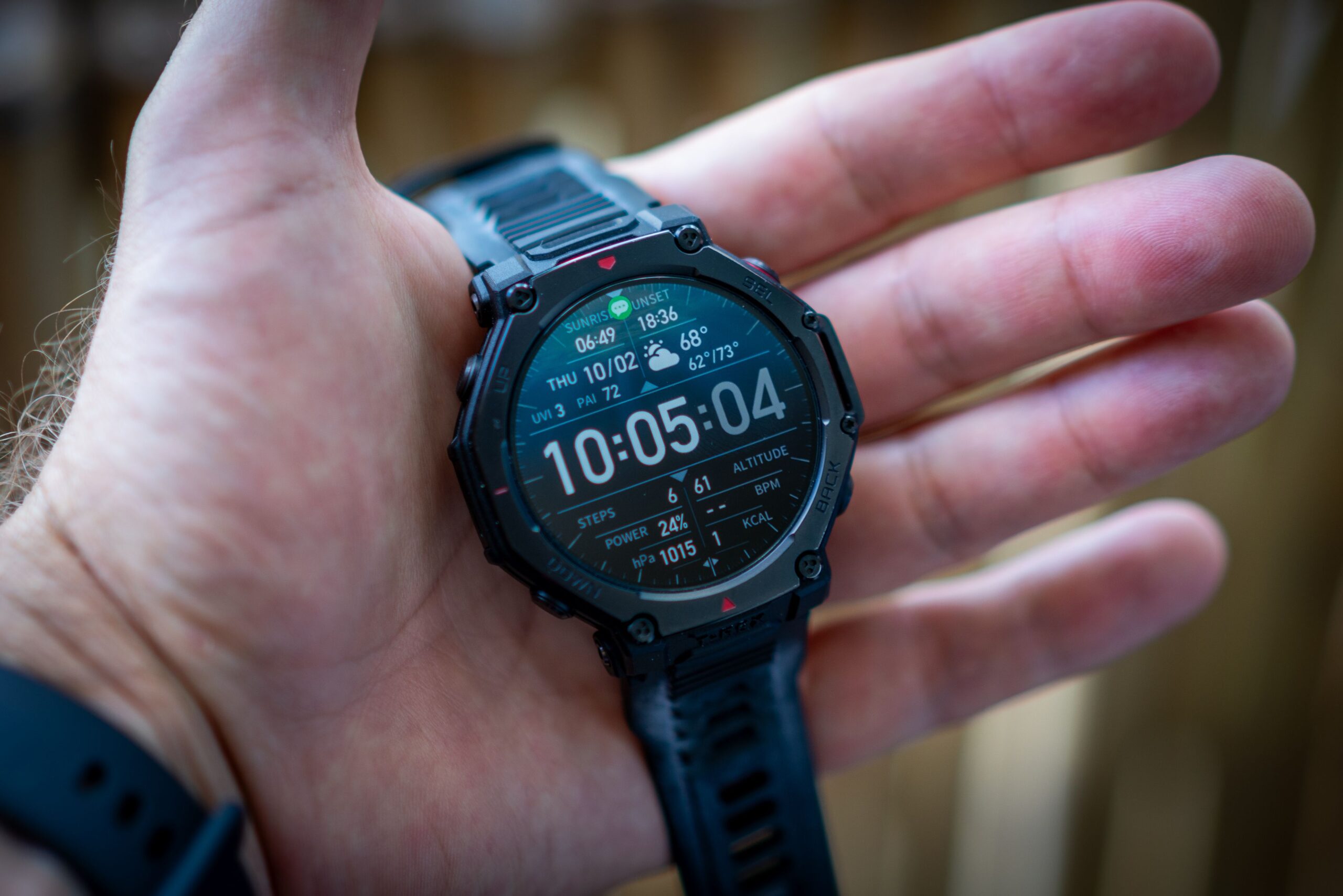Originality is an undervalued feature. Sure, every company takes other companies’ ideas, iterates on them, and hopefully improves them, but originality and innovation score extra points in my book. Obviously, I would like every product to be original and good, but even if it’s bad, hey, I salute people at least for trying something new.
But then, on the other side of the coin, we have knockoffs. The T-Rex 3 Pro is Amazfit’s stab at making a Garmin Fenix 8, which is in my opinion the current best fitness tracker money can buy. The only problem is that it costs $1,100. The idea that you could have a watch with Garmin features and materials for $400 is very appealing, but it does have a lot of problems.
Beat for Beat

Photograph: Brent Rose
The watch itself is a 49-mm rounded octagon that is 14mm thick. When you compare the specs, it’s technically smaller than the Fenix 8, but a side-by-side comparison looks (and feels) like it’s chunkier. Impressively, the T-Rex 3 Pro also features a titanium bezel and a nearly scratch-proof sapphire screen covering an AMOLED display that puts out an impressive 3,000 nits, which makes it noticeably brighter than the Fenix 8 (though not as bright as the new $2,000 Fenix 8 Pro MicroLED, which puts out 4,500 nits).
Its battery lasts up to 25 days, which is more than a week longer than the Fenix 8’s 16 days. It also has virtually all the sensors you’ve come to expect for 24/7 health tracking, plus some more advanced features like a depth sensor for diving activities, and there’s a microphone and speaker, and a red and white LED flashlight (all features on the Fenix 8). There’s also a 44-mm version that has all the same features, except battery life drops to 17 days.
It’s also the first non-Garmin watch that proclaims to have offline routing and rerouting (hold your “woo-hoo” until later). The AI assistant, Zepp Flow, can help you start activities and even answer some basic questions like metric conversions, and the mic and speaker allow you to take phone calls with your wrist (as long as it’s within range of your phone’s Bluetooth). It also features more than 180 sport modes, so it can track just about any activity you can do. So what’s the catch?

Photograph: Brent Rose
Everything. Everything about the user experience is the catch. It’s the catchiest catch. Virtually every screen, every quest to change settings, every attempt to do even more the most rudimentary thing left me wanting to tear my hair out. It’s almost impressive how bad it is.
For starters, virtually everything takes more button clicks than it should, and menu items are rarely where you expect them to be. Sometimes you have to fully end an activity (not simply pause it) in order to get to the main menu and fix whatever needs fixing. If you try to circumvent that by long-pressing the top right button to get to Zepp Flow, you are in for a ton of lag. Sometimes it takes Zepp Flow eight seconds to respond. Or maybe never at all! It’s very frustrating.
The watch has 26GB of storage (for music and maps), so you can install MP3s if you have some saved on your computer, but the watch has none of your favorite music apps, which means no offline streaming. You can use it to control the music playing from your phone, but then you must have your earbuds connected to your phone, rather than your watch. And so on, and on, and on. This is Fitness Tracker 101 stuff. Playing music should be easy.
More Software

Photograph: Brent Rose
The T-Rex 3 Pro gives you a morning report that tells you about your sleep, how well you recovered from yesterday’s activities, and more. BioCharge is what Amazfit calls its version of Whoop Score or Garmin’s Body Battery, but you can’t click through to see details. It gives you the headlines, without access to the articles.
One of the reasons that Garmin watches cost so much is that they come with detailed, routable maps of all North America preinstalled, which includes features like ski resorts and cycling-specific maps. Using offline maps on the T-Rex 3 Pro is much more like using an Apple Watch or Pixel Watch—you have to install maps through Amazfit’s app, which is … also not great. It took five minutes just to download one-third of Los Angeles, which is very annoying if you’re traveling and just want to get out the door for a quick run.
Trying to set up a running program in Zepp Coach was also wonky. The setup was OK—it asked me questions about how much I’m running, when my race is, what kind of time I’d like to finish in, etc. So far, so good. But its first suggestion was way too long a run, at too slow a pace, and I couldn’t figure out how to edit the parameters. Then, suddenly, one mile into the run, a golden trophy popped up on the watch’s screen and it said, “Training Completed,” and then froze the screen. I couldn’t see any of my stats. I still don’t know what the watch thought I did.

Photograph: Brent Rose
Offline routing is supposed to be one of the banner features of this watch. You should be able to just pick a point in the Maps app on the watch, then choose Straight-Line Navigation or Route Navigation. Unless you’re in a wide-open field, Straight-Line won’t help you much, but Route Navigation should parse the watch’s ability to read roads and trails to get you where you’re going.
Then you choose between Outdoor Running, Walking, or Outdoor Cycling. Why isn’t hiking included? Who knows, but it doesn’t really matter because 90 percent of the time I tried it, the watch would just say, “Route Creation Failed. Try Again.” I only managed to get it to work a couple of times, and only for extremely short distances, and one of those times it advised me to run on Interstate 405, which is one of the largest, busiest highways in the country. I would not rely on this feature.
There’s just a general sense of unfinishedness to the whole thing. Questionable translations abound. It missed waves while I was surfing. It still doesn’t recognize the types of strength training that you’re doing, which is a feature that was promised earlier this year and is readily available on all other sports watches at this point.
Finish the Job

Photograph: Brent Rose
It’s not all bad news. I love that this watch has an LED flashlight, which is a feature that I think every sports watch should have because it’s so useful. The speaker and microphone aren’t great quality, but they’re also nice to have. The watch does a pretty good job of displaying notifications from your smartphone, and if you’re an Android user you can even quickly reply to incoming texts, or initiate texts through Zepp Flow, even though it doesn’t draw distinctions between types of notifications and it will just start buzzing incessantly while you’re driving.
The GPS is pretty accurate, and while the heart rate monitor isn’t as good as Garmin’s (or Polar’s, or Apple’s, or Google’s) it’s not awful. Zepp Flow is surprisingly capable as a standalone AI assistant, and it actually has more functionality and can answer a wider range of questions compared to Garmin’s built-in AI.
Zepp Pay does not work in the United States, and that’s a huge loss. It also made me wonder what regulatory hurdles it hadn’t cleared. Amazfit has a history of hiding its privacy policy, and while it has since remedied that, it’s hard to restore that trust once it’s lost. It just doesn’t have as long a history as companies like Apple, Google, or Garmin. That’s the thing with knockoffs, though. If you want to buy a fake Rolex on Canal Street, hey, it’s a one-time cash purchase. But do I really want those Canal Street guys to know where I live, have all my biometrics, and be able to read my incoming texts and see who I call? That might be unfair, but it’s hard to not be suspicious.
Ultimately, I understand why this watch exists. The Fenix 8 is massively expensive, and there are a lot of multisport athletes that want those features but don’t want to spend that much money. If that sounds like you, I’d recommend looking at Garmin’s Instinct 3 series, or an older Fenix 7, both of which can be had for around $400-$500. You won’t get every single feature, but the features you do get will actually work, and you’ll save yourself a lot of frustration.




